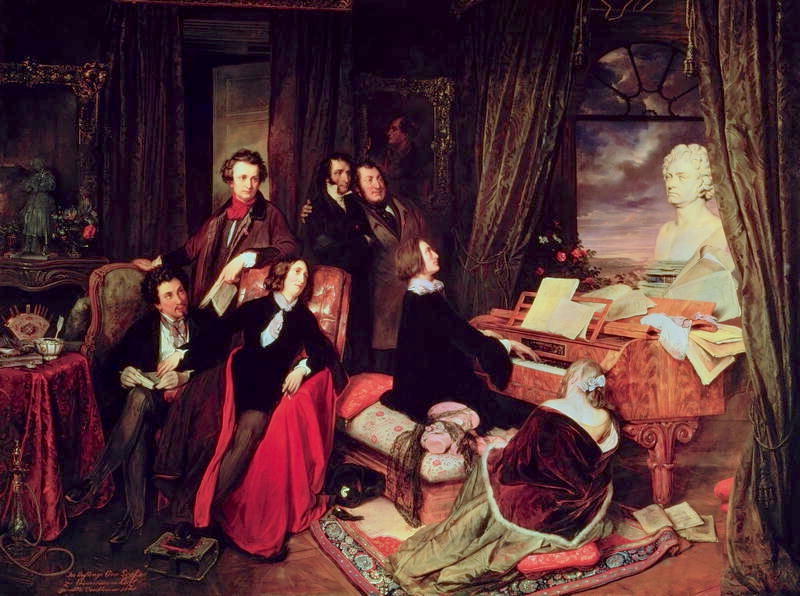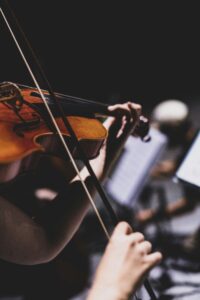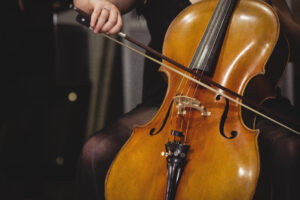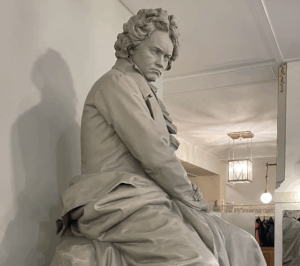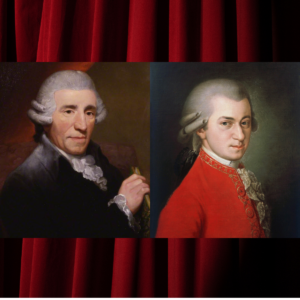KEY TAKEAWAYS:
• Beethoven was the first composer to include key principles of Romanticism in his music, marking the end of the Classical era.
• Another major composer, F. Schubert, wrote most of his works in the Romantic style, unlike Beethoven, who in his early life was more Classical.
• Romanticism lasted longer in music, and with each new generation, it changed dramatically.
In music, the Romantic era came later, at the beginning of the 19th century. It was a time of some of the most famous masterpieces and iconic composers – Franz Liszt, Frédéric Chopin, Johannes Brahms, to name a few…
Romantic music was nothing like Classical. While Classical-period music focused more on structure and musical perfection, Romantic composers cared more about self-expression.
That’s why Romantic music sounds so calm and dreamy or, on the contrary, so dramatic and intense – totally different from Haydn or Mozart’s playful tunes. This is when music really started to become meaningful, reflecting the composer’s imagination and inner world.
While it’s clear that Romantic music was different from earlier epochs, it’s quite tricky to define the exact moment of transition between Classical and Romantic. So, who was the first to bring the ideas of Romanticism into music?
Today, we’re going to dive into the question: “Who was the first Romantic composer?” We’ll explore how Romantic music came to be, the composers who led the charge, and how their works became the foundation of all Romantic music. Let’s jump in!

Subscribe to Classical Echoes Newsletter!
What is Romanticism and when it started
Romanticism began emerging in the 1770s, first influencing art, literature, and philosophy before eventually making its way into music. Rather than focusing on strict rules and complex structures, Romantic artists prioritized imagination, creativity and, above all, individualism.
The movement initially took shape in literature. Writers like Byron and Goethe began to shift their focus toward deeply developed characters, themes of heroism, and supernatural elements rather than traditional storytelling.
In painting, artists such as Francisco Goya and Caspar Friedrich began depicting mysterious landscapes, becoming more creative and imaginative.
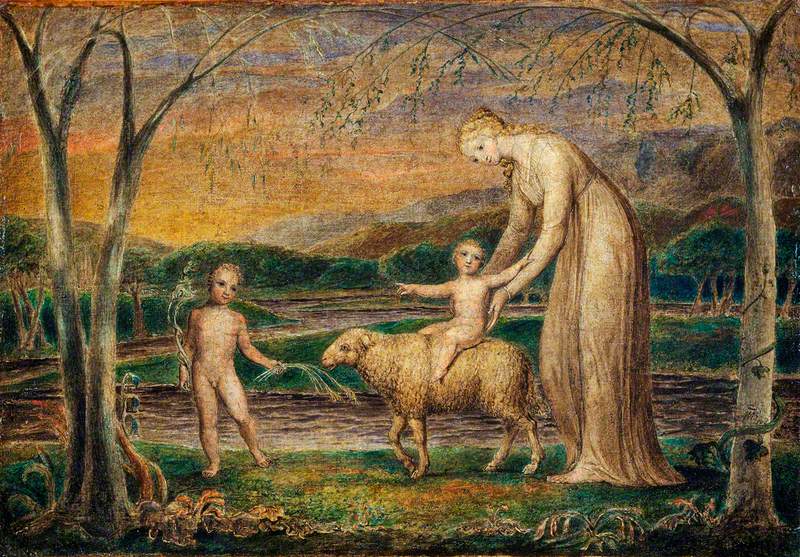
The music, on the other hand, was one of the last art forms to experience these changes. The first Romantic composers started to emerge only in the 1820s, and Romanticism in music lasted until the early 20th century.
In the late 18th century, leading classical composers like Haydn and Mozart were still composing mostly in the Classical style. They primarily focused on developing main themes and melodies within established compositional standards.
Nevertheless, the spirit of change was in the air, and someone had to revolutionize music as we knew it. One of these heroes was undoubtedly Ludwig van Beethoven, whom we will discuss in detail.
Related
Beethoven – The Father of Romanticism?
Let’s take a closer look at Beethoven, a key figure in music. He was supposed to become the next Mozart, but instead, he created his own vision and philosophy that changed music forever, bringing the Classical period to an end.
Beethoven’s father, an unsuccessful singer and music teacher, wanted Ludwig to be a musical prodigy.Even though his father chained him to the piano and hit his hands when he played the wrong key, Beethoven’s passion for music never faded.
Young Beethoven idolized Mozart, whose music he considered supreme. In 1787, he even traveled to Vienna, hoping to learn from him.
But then Mozart died, and Beethoven’s hopes to learn from the greatest classical composers died with him. A few years later, Beethoven studied with Haydn instead, but their views on music didn’t align.
Haydn followed strict Classical traditions, while Beethoven saw music as more philosophical form of self expression. He once said that Haydn taught him nothing – so yeah, that tells you how well it went.
The French Revolution of 1792 deeply influenced Romanticism, and Beethoven in particular, with its ideas of fighting for freedom. His views became even more modern and idealistic.
He started to see music as something bigger than just structured, beautiful sounds – it became a way to depict abstract ideas like triumph and heroism.
His Eroica Symphony was originally dedicated to Napoleon, whom he saw as a hero of the revolution. But when Napoleon declared himself emperor, Beethoven was furious and scratched out the dedication.
The defining characteristics of Beethoven’s style are most evident in his piano sonatas. In almost every new work, he pushed music to new extremes – building it on contrasts and unpredictable, more complex structures.
His later works, like the Ninth Symphony or Hammerklavier Sonata, became a turning point in music. Their scale and grandeur make them more than just musical pieces. They are monumental philosophical works, full of bold statements and passion.
Moonlight Sonata, 1st mov. – one of the earliest examples of Romanticism in music (yt. Unity Rebound)
Romanticism in Schubert's music
Okay, so by now, it’s clear that Beethoven completely changed the course of music. But the truth is – throughout most of his life, he was still a Classical composer.
Take his early sonatas or piano concertos, for example. Of course, they gained Beethoven fame and recognition, but they weren’t as revolutionary as his later works.
Young Beethoven was more modern and progressive for his time but still followed the traditions of Mozart and Haydn.
While Beethoven was more conservative in his music, a new, shy genius appeared on the scene – Franz Schubert.
Overshadowed by Beethoven’s fame, Schubert wasn’t as influential in Vienna, but his music was unique and different from other composers.
Unlike Beethoven, whose landmark works were his piano sonatas, for Schubert this was his lieder (songs). He wrote over 600 throughout his life, many with deep meaning and feelings.
If we’re talking about a composer who truly embodied the Romantic spirit in his music from the very beginning, Schubert was one of the first.
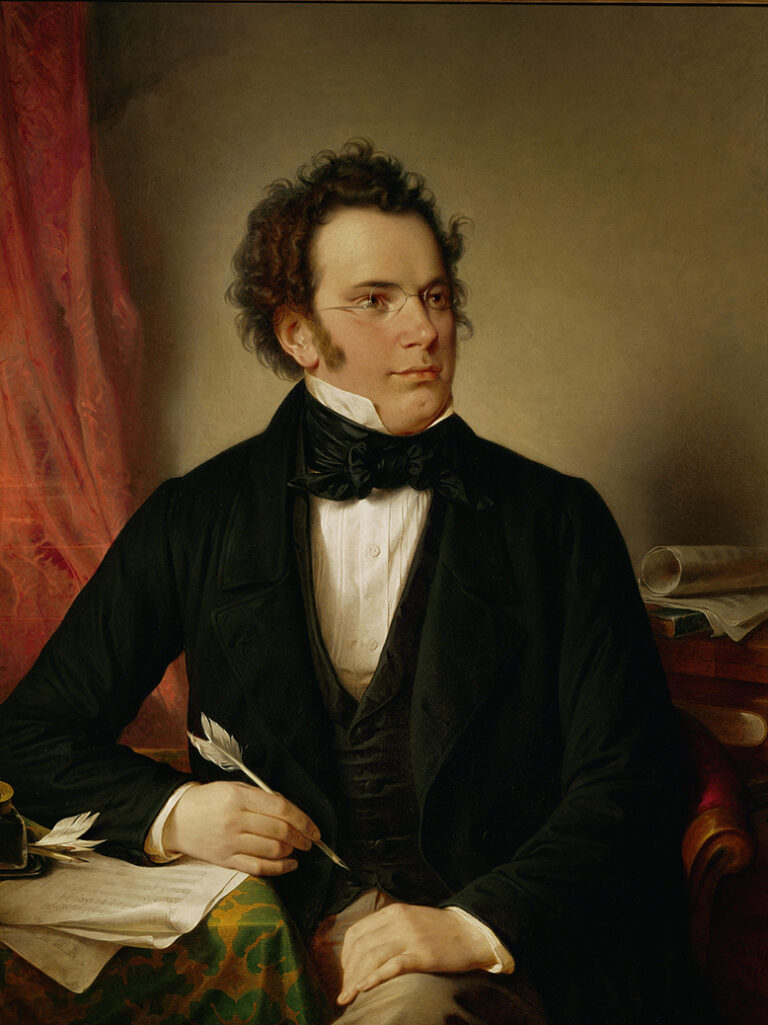
F. Schubert – Getty Images
One reason his music is so emotional is his tough life. Imagine a young man, barely over five feet tall, round glasses perched on his nose, socially awkward to the point where even his friends affectionately nicknamed him “Mushroom” because he preferred dark, quiet spaces.
His financial situation and intense life in a big city like Vienna didn’t make his life easier. Unlike Beethoven, who had the support of wealthy patrons, Schubert largely survived thanks to a small circle of admirers known as the Schubertians.
Yet, despite all of life’s hardships, his musical output was astounding. In addition to 600 lieder, he completed 21 piano sonatas, 9 symphonies (including the unfinished 7th and 8th), piano trios, and string quartets.
Many of his works are full of drama and emotion. In now-famous Erlkönig or Der Doppelgänger, he creates a dark and intense atmosphere to evoke particular feelings in the listener.
While Schubert and Beethoven were completely different composers in terms of their music, Schubert idolized Beethoven. Beethoven had a huge influence on him, even though Schubert was overshadowed by him.
Beethoven, on the other hand, barely knew Schubert existed, and there’s no evidence they ever met.
Schubert was so painfully shy that, on one occasion, he spotted Beethoven in a coffeehouse and immediately turned and walked away. He simply couldn’t bring himself to approach him.
Schubert’s works were eventually brought to the dying Beethoven, who declared, “Truly, the spark of divine genius resides in this Schubert.” Coming from Beethoven, that was the highest possible praise.
Schubert even served as a torchbearer at Beethoven’s funeral in 1827. At that moment, he was probably the greatest composer left in Vienna. Just a year later, Schubert died and requested to be buried next to Beethoven.
In fact, Schubert’s later works are among the most emotional and powerful in all of music. Knowing he was dying, death became a central theme in his late compositions – especially the meaning of death in human life.
His last three piano sonatas and the string quartet Death and the Maiden are some of the finest examples of early Romanticism and influenced the next generation of composers.
While Beethoven’s Romanticism was often more abstract, Schubert wanted to create strong image of death, expressing its nature through music – his personal struggles, emotions, and things words couldn’t describe.
Of course, not all of Schubert’s music was dark. He also wrote beautiful, expressive pieces about love and the simple joys of life. His short and difficult life is reflected in his music – it can be deeply melancholic yet incredibly peaceful and full of beauty.
Early Romanticism in music
So far, we have discovered that Beethoven was the bridge between two epochs and implemented the key principles of Romanticism in his music. Meanwhile, Schubert was the first major composer to incorporate Romantic ideas throughout his life.
Indeed, the new generation of Romantics really started to experiment with their music, unveiling new styles. Their music became more self-expressive and seemed to take on new meaning.
Now, famous Romantics like F. Liszt, Schumann, Mendelssohn, Chopin, and Offenbach often aimed to tell a story or express feelings through music. However, they all received more or less influence from Beethoven and Schubert.
Franz Liszt, in particular, considered Beethoven one of the most important musicians, describing him as:
“To us musicians, the work of Beethoven parallels the pillars of smoke and fire that led the Israelites through the desert—a pillar of smoke to lead us by day and a pillar of fire to light the night, so that we may march ahead both day and night.”
Beethoven and Liszt once met when the elderly Beethoven was impressed by the playing skills of young Liszt and his musical prodigy. Later, Liszt transcribed all of Beethoven’s symphonies for piano, along with other works.
He was also the first recorded performer of some of Beethoven’s piano works that, at the time, were considered unplayable. In 1831, he performed the complete Hammerklavier Sonata and pushed the possibilities of piano to new boundaries.
Both Liszt, Mendelssohn, and Schumann admired Schubert’s music. Liszt transcribed many lieder like Der Erlkönig, Doppelgänger, and Ständchen for solo piano.
Mendelssohn, being wealthy and owning his own orchestra, performed many of Schubert’s works that had gone unnoticed during Schubert’s life, such as his 9th Symphony “The Great” and other orchestral pieces.
Chopin and Brahms took inspiration from many early Romantic works like Beethoven’s Moonlight Sonata and Appassionata. Of course, their music was completely different from Beethoven’s or Schubert’s.
In fact, during the Romantic era, music started developing much more rapidly than in the Classical period. It finally established itself as a major form of art, and the composer’s personality became a central aspect of their music.

